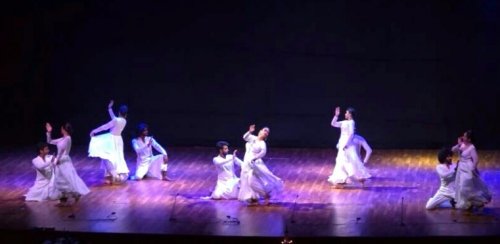
|   |

|   |
Kadamb's Vivarta enthralls - Dr. S.D. Desai e-mail: sureshmrudula@gmail.com Photos: Hardutt Trivedi March 29, 2017 The lyrical quality of Pt Bindadin Maharaj's verbal composition Hey... Niratata Dhang is felt in its short evocative lines. Nearly each line has softer sounds of monosyllabic, bi-syllabic or tri-syllabic words. Relatively stronger sounds occur in only one of its seven chiseled quatrains which portray the brilliance of the poem's central character brajabhaan nandani paapakhandani Radha. The syllables are not as strong for shri krushna ki chhavi in the next and subsequent stanzas lest there should be a harsher note in portraying His all-pervading benignity! The verses compactly portray the structured elevation of the classical Kathak as we know it today and the piece has been used as its laksshan geet (song of its salient qualities) by gurus and teachers of the dance form. In an inspired conceptualization of the essence of the verses and their imaginative visualization, Kumudini Lakhia of Kadamb offers in Vivarta, one of her outstanding dance productions something of a karna-chaakshusotsava to rasikas. Madhup Mudgal, who was present to see the performance at the newly built Pt Din Dayal Auditorium on March 22, has made a complementary creative contribution to Vivarta capturing its varying moods in varying appropriate ragas.
All dainty segments of Vivarta, which means a total change from what it was like earlier, stand out distinctly - aurally as well as visually, considering how even the junior dancers get integral to it, how hard and with understanding the performing team has worked and with what care the choreographer has shaped them! Light designer Gyan Dev gets brilliantly noticed with his contribution to an appropriate changing ambience and an unassuming Anuvi Desai helps the characters assume identity with her costume designs, working with taste on the choreographer's suggestions. Strains of Bahe pavana manda sugandha... waft across to the viewers' imagination in the dark even before the curtain opens and, as it opens, they get transported to now a never-never land where the gently flowing breeze carries the fragrance, it's so cool along the river Yamuna and so lovely with pretty girls, youthfully joyous and languid in the shringaar mood, at play as Gopis, Radha and Krishna on narrow shrubs-and-creepers-clad pathways. Six girls (Rupanshi, Mitali, Bhakti, Manasi, Nao, Vidhi) one indistinguishable from another in their pink and peach attire with just flickers of basic colours showing up once in a while, in lyrical movement weave innumerable intricate patterns drawn from nature with their anguli-nartan. With masculine energy and elegance and aplomb taking over, the next sequence is in complete aesthetic contrast. It's time for celestial music as Brahma blows the conch, Naarad plays the veena, Lord Shiva the damru as Shrungi recites Shaarada Swaras. In achkan and churidar reflecting a divine glow, the boys from Kathak Kendra, New Delhi (Souvik, Mukesh, Rohit, Mohit, Abhishek), measure up in pace and vigour to the changing music in Dhamar. Their demeanour and movement are stately. Neither in Bindadin's kavit nor in Kumudini's choreography is Krishna visibly prominent though his omnipresence is felt as much by the viewers as the gopis. Both try to portray Radha with delicate care. A harbinger of joy, vrajabhaan nandani emerges leaping out as if from a Moghul painting in rich attire bedecked with, in the poet's concept, koti ravi shashi. As a roopagarvita nayika capable of intricate abhinaya, her eyes glowing, Sanjukta Sinha rises in the Thumri and portrays Radha. The Raasleela - in which sakhis (Shweta, Arohi, Kriti, Aakanksha), beaming with a smile with tiny cymbals in hand, gracefully moving, participate - that follows marks the celebration of the iconic pair's inspiring union. One gets reminded that suggestion is always the hallmark of Kumudini's choreography.  Seated as in a royal court the boys and girls in the next stage of Kathak's evolution with delectable playfulness exchange bols in a variety of aural patterns. In a celebratory Tarana, danced as in the open in the moonlit tranquil night, the dancers clad fully in white and the lights highlighting the white, come together to create enthralling climactic moments in all conceivable formations. There is an effortless chivalric message, contemporary in our social context, suggested in the line Gopi kuch par sham kar sohe-n maano baithe bhujang... The dancers, echoing the poet's lines finally invoke such Naath for protection. Dr. SD Desai, a professor of English, has been a Performing Arts Critic for many years. Among the dance journals he has contributed to are Narthaki, Sruti, Nartanam and Attendance. His books have been published by Gujarat Sahitya Academy, Oxford University Press and Rupa. After 30 years with a national English daily, he is now a freelance art writer. |